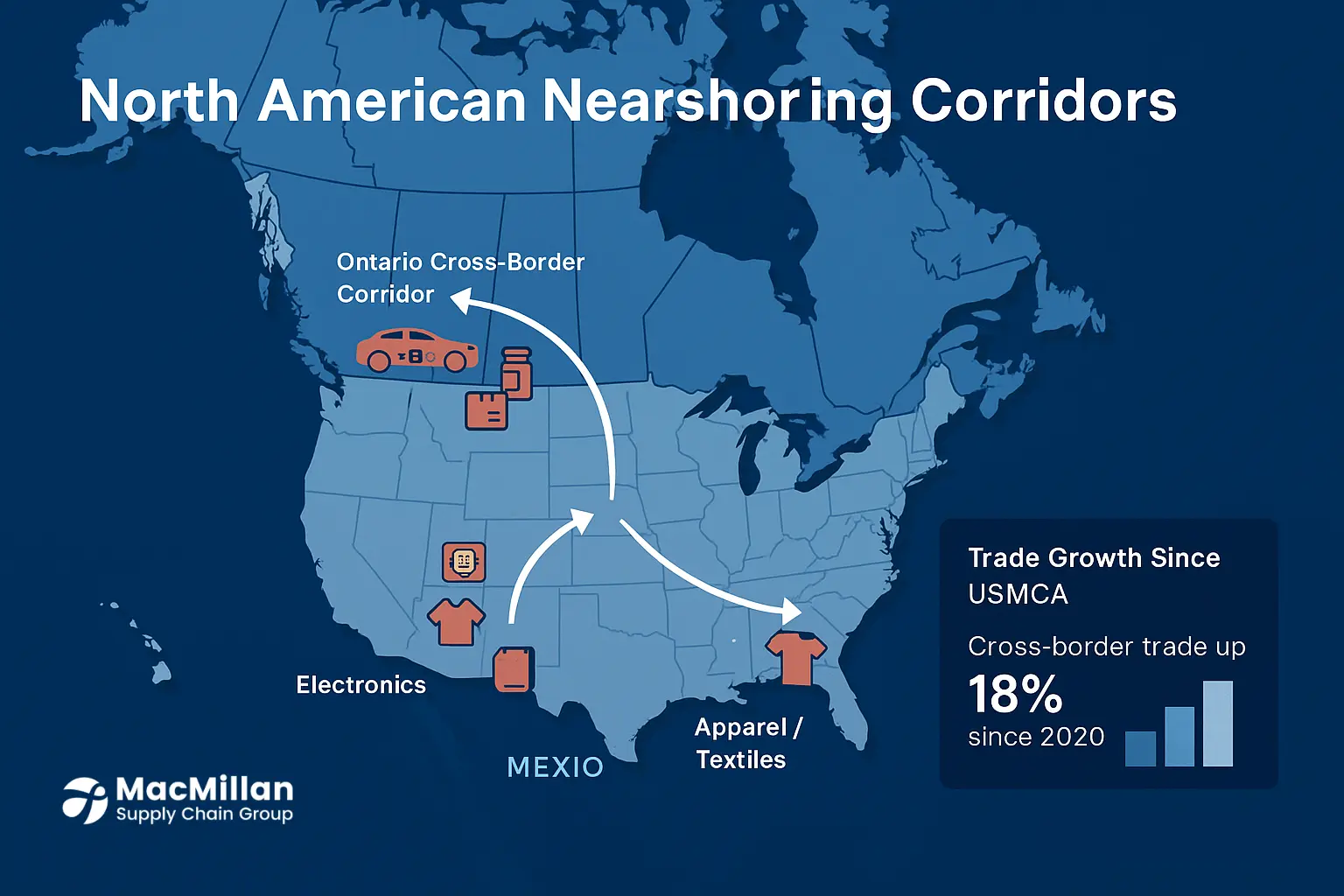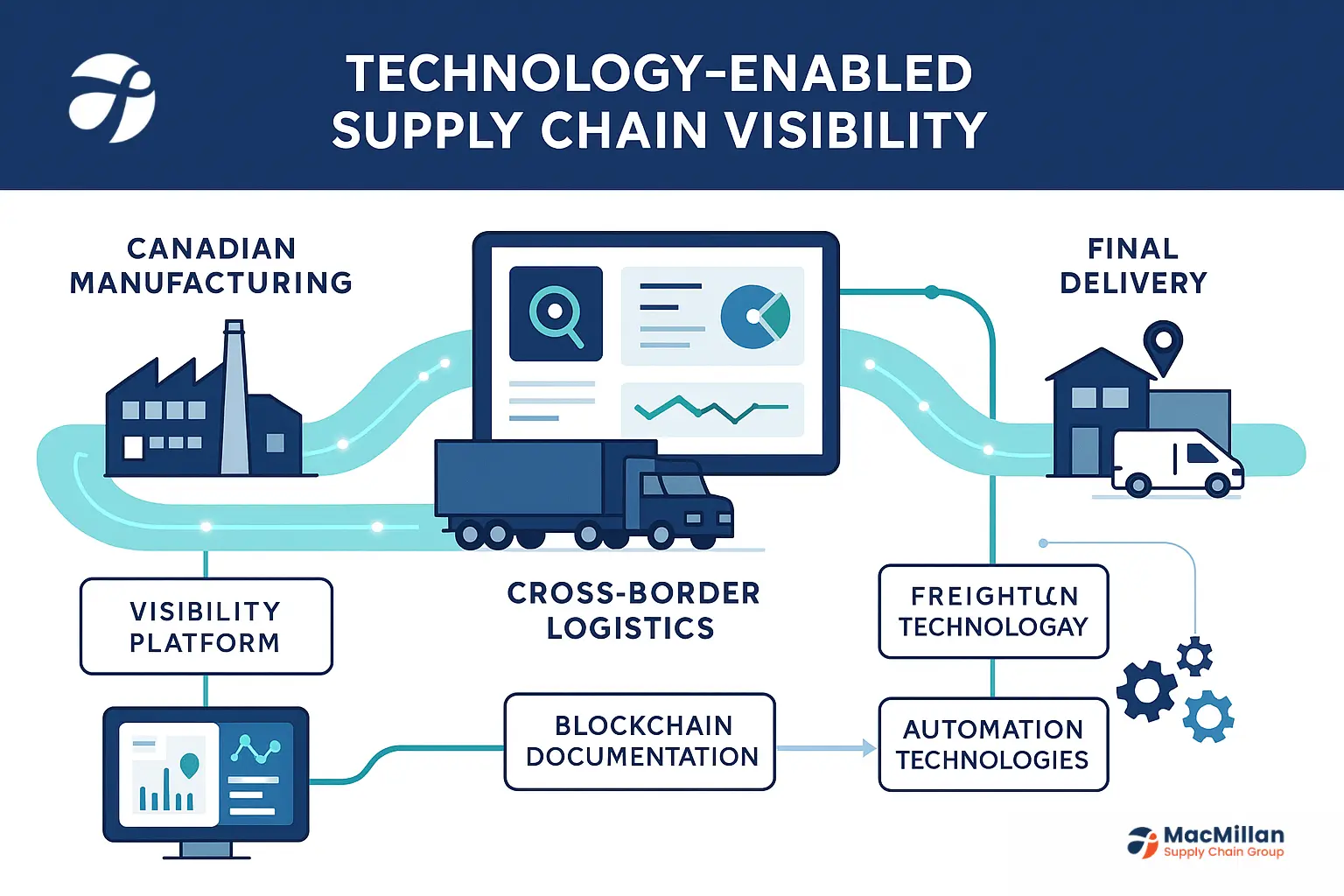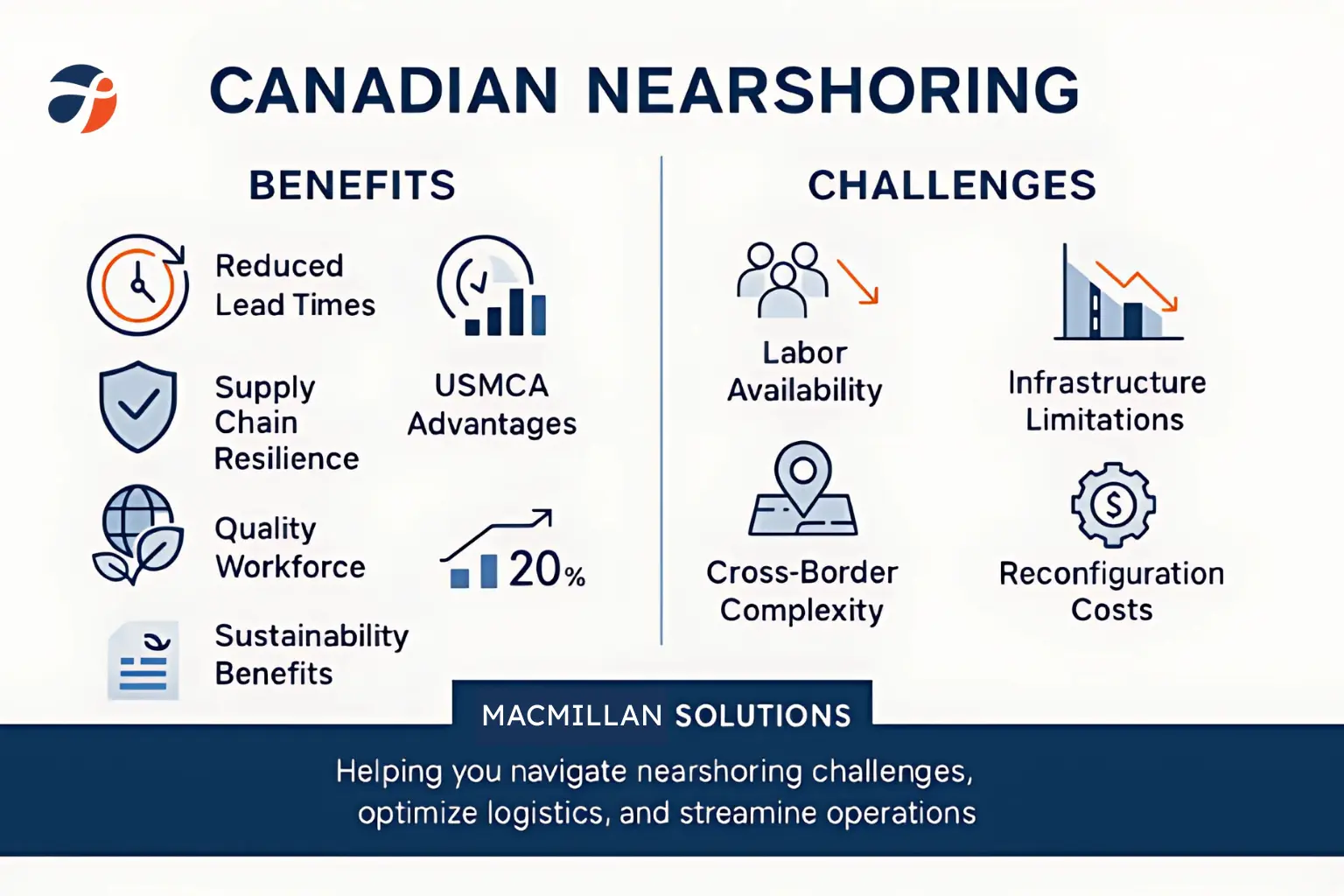A Quick Summary and Overview
Logistics in the region will be drastically altered by Canadian nearshoring, which is the deliberate relocation of manufacturing and supply chain activities closer to North American end markets, by 2025. The shift from Asia-centric production to regional hubs across Canada, the US, and Mexico is being accelerated by the USMCA trade agreement, post-pandemic lessons, and growing geopolitical risks. Canadian businesses encounter both new opportunities and challenges as manufacturing hubs appear, cross-border logistics change, and technology reimagines operations. MacMillan Supply Chain Group is spearheading this change by providing specialized logistics solutions that enable resilient, effective, and sustainable nearshoring tactics.
Introduction
Global supply chain dynamics are undergoing a dramatic change for the first time in decades. The movement of goods across North America has been redefined by Canadian nearshoring, which has become a dominant strategy by 2025. This shift signifies a fundamental realignment of supply chain priorities from global to regional and from long-haul to local.
Businesses in Canada have unique opportunities as a result of the growth of Canadian nearshoring. The need for skilled logistics is growing as new manufacturing hubs are being established along corridors like Ontario’s. Businesses are looking for partners who are knowledgeable about local laws, international issues, and the cutting-edge technology required to oversee complex supply chains.
At MacMillan Supply Chain Group, we are seeing the real-world impact of Canadian nearshoring every day. It’s more than relocating production—it’s transforming how goods are transported, stored, and delivered across North America. Let’s explore what this means for your business.
The Growth of Canadian Nearshoring
Canadian nearshoring is a top option for manufacturers in 2025 due to a number of factors.
The USMCA agreement has improved the smoothness of trade throughout North America. Market access has been enhanced, tariffs have been lowered, and customs procedures have been made simpler. As a result, Canada is positioned as a key production location with easy access to American consumers.
Canada’s political stability and intellectual property protections are more appealing than ever in light of the increasing instability in the world. Canada is now seen by high-tech manufacturers as a safe place to conduct sensitive R&D and production activities.
The country’s skilled workforce, trained in automation, manufacturing, and supply chain management, is another key asset. With advanced production reshoring to North America, Canada’s educated talent pool supports innovation and efficiency.
“Since 2023, we’ve seen a 35% spike in inquiries about Canadian warehousing,” says a MacMillan logistics analyst. “Businesses are looking for integrated solutions that connect Canadian production with North American markets.”
This trend is especially visible along the Ontario transportation corridor, where industrial development has accelerated to support nearshoring demand. The corridor’s strategic location offers fast access to the US, along with top-tier infrastructure and labor quality.
 Cross-Border Logistics in the Age of Nearshoring
Cross-Border Logistics in the Age of Nearshoring
As Canadian nearshoring accelerates, cross-border logistics are evolving rapidly. The flow of goods between Canada, the US, and Mexico is increasing, requiring more sophisticated logistics networks.
Gone are the days of simple border trucking. Logistics firms now deploy multi-modal, tech-enabled strategies that optimize speed and cost. MacMillan Supply Chain Group offers fully integrated services linking Canadian production to US and Mexican distribution networks.
Technology plays a major role. Real-time shipment tracking and automated customs documentation reduce delays and improve reliability. Companies can now manage international shipments with greater visibility and fewer disruptions.
Border infrastructure has also improved. Investments in commercial lanes, pre-clearance programs, and automated inspections have eased congestion. Especially along Ontario’s corridor, crossing the border is now faster and more predictable.
“The border isn’t the obstacle it once was,” explains a MacMillan expert. “With the right logistics partner, companies can treat the US-Canada border as just another stop.”
This evolution in cross-border logistics is making Canadian nearshoring more attractive by removing traditional barriers and unlocking access to the broader North American market.
Technology Enabling Canadian Nearshoring
Technology has been instrumental in supporting the rise of Canadian nearshoring and managing the complexity of regional supply chains.
Real-time visibility platforms are essential for tracking inventory and shipments from production to final delivery. For nearshored supply chains, this visibility is crucial for cross-border planning and maintaining delivery reliability.
“Clients demand precise location updates,” says MacMillan’s tech director. “Our visibility platforms ensure they always know where goods are—whether in a Toronto warehouse or crossing into Michigan.”
AI-powered freight platforms optimize routing by analyzing weather, traffic, and border wait times, enabling more efficient logistics. Automation tools—from robotic pickers to AI inventory systems—boost throughput and reduce manual labor in Canadian warehouses.
Blockchain technology is increasingly used for supply chain documentation, creating transparent, secure records and simplifying compliance under USMCA.
These tools have made Canadian nearshoring more viable, cost-effective, and scalable for companies seeking supply chain resilience and proximity to the North American customer base.
 Industry-Specific Effects of Canadian Nearshoring
Industry-Specific Effects of Canadian Nearshoring
Different industries are experiencing the impacts of Canadian nearshoring in unique ways, and MacMillan Supply Chain Group is adapting to meet these evolving needs.
The automotive sector, especially EV battery production, is leading the shift. EV batteries are heavy, sensitive, and expensive to ship globally—making nearshoring an ideal solution. Canada is becoming a key hub for EV battery production supporting US assembly plants.
“Battery logistics require precision and safety,” says a MacMillan expert. “We’ve developed specialized solutions to handle these challenges across North America.”
Pharmaceutical and medical device companies are also turning to Canada for production, drawn by strong regulation and a skilled workforce. These sectors need temperature control, detailed documentation, and secure transit—services that MacMillan provides with confidence.
Consumer electronics firms are nearshoring final assembly to North America while keeping component sourcing global. This hybrid model needs agile logistics that coordinate inbound components and outbound distribution efficiently.
Some businesses are adopting a North American nearshoring strategy, splitting production between Canada and Mexico based on each country’s strengths. MacMillan helps coordinate cross-border flows across the entire USMCA region.
Challenges of Canadian Nearshoring
Despite its benefits, Canadian nearshoring presents several operational challenges.
Relocating production requires investment in new facilities, training, and equipment. The upfront costs can be difficult to justify, even when long-term savings and risk reductions are clear.
Labor shortages are also emerging, particularly in skilled manufacturing. Canada’s workforce is strong, but demand is high, and competition is fierce—potentially leading to wage inflation and staffing gaps.
Cross-border complexity remains an issue. Regulatory differences between the US, Canada, and Mexico require careful compliance management, especially for labor laws, product standards, and documentation.
As freight volumes rise, infrastructure constraints become more apparent. There are few prime warehouse locations, and some transit corridors are getting close to being congested. There might be more expenses and fewer options for late movers.
Businesses may lose end-to-end visibility as supply networks change, which raises the possibility of service interruptions or inventory delays.
Placing inventory in different countries also becomes more complicated. A logistical and financial challenge is managing inventory while striking a balance between cost, service quality, and working capital.
 MacMillan’s Nearshoring Solutions
MacMillan’s Nearshoring Solutions
MacMillan Supply Chain Group addresses Canadian nearshoring challenges with integrated logistics and advisory services.
Our cross-border logistics services simplify movement across Canada, the US, and Mexico. We handle documentation, compliance, and customs, making trade seamless. Our deep understanding of USMCA provisions helps clients minimize tariffs and maximize trade efficiency.
“Our job is to make borders invisible,” says our logistics director. “We handle the complexity so our clients can stay focused on growth.”
We provide real-time visibility, predictive analytics, and automation through our logistics platform. This transparency helps companies manage their regional supply chains with confidence and control.
Our warehouse network, especially along the Ontario corridor, offers scalable, tech-enabled storage and distribution. Clients can adjust capacity as their nearshoring operations grow.
We support specialized industries with customized logistics for pharmaceuticals, EV batteries, and high-value electronics—where security, compliance, and speed are non-negotiable.
Finally, our advisory team helps clients design effective Canadian nearshoring strategies. We offer supply chain analysis, network design, and sustainability optimization—ensuring smooth transitions and long-term performance.
How to Execute a Canadian Nearshoring Strategy
Planning, professional assistance, and meticulous execution are necessary for a Canadian nearshoring strategy to be successful.
Do a thorough supply chain audit first. Determine which products and parts are most appropriate for nearshoring based on factors like cost, lead time, and strategic significance.
Analyze all of the landed expenses. Think about more than just unit costs; take into account risk, inventory, shipping, and tariffs. When you look at the big picture, Canadian nearshoring frequently yields a higher return on investment.
Build partnerships with logistics experts who know the North American market. MacMillan offers the infrastructure, tools, and experience to guide your nearshoring journey.
“Choosing the right partner is crucial,” says our senior consultant. “You need flexibility, regional reach, and a proven record in USMCA logistics.”
Prepare contingency plans for disruptions. Nearshoring improves resilience but doesn’t eliminate risk. Backup suppliers, alternate routes, and safety stock can protect continuity.
Ready to explore how Canadian nearshoring can reshape your supply chain? Contact MacMillan Supply Chain Group today. Our experts are here to help you build a stronger, smarter, and more regional supply network.
Follow us on LinkedIn for real-time tariff updates
FAQS
Nearshoring involves moving production or sourcing to countries that are geographically close to your target market—like Canada or Mexico for North American companies. Reshoring, by contrast, means bringing production back to your home country. The key difference is that nearshoring leverages the advantages of nearby countries (often lower costs or specialized capabilities) while still maintaining proximity to your customers. In the Canadian context, many US companies are nearshoring to Canada to benefit from our skilled workforce and USMCA advantages.
The USMCA has created a more integrated North American market by reducing tariffs and streamlining cross-border trade. It includes specific provisions that encourage regional manufacturing, particularly in sectors like automotive where content requirements promote North American production. This agreement makes Canadian nearshoring more attractive by ensuring preferential access to the US market and creating a more predictable trade environment. MacMillan Supply Chain Group helps clients navigate USMCA requirements to maximize these benefits.
Several sectors are leading the Canadian nearshoring trend. EV battery production in Canada is growing rapidly, supported by abundant clean energy and government incentives. Advanced manufacturing, particularly for medical devices and aerospace components, is expanding due to Canada's skilled workforce. Pharmaceutical production is increasing as companies seek regulatory-friendly environments. Food processing is another growth area, with companies leveraging Canada's agricultural resources and food safety reputation.
Nearshoring typically reduces transportation costs and transit times compared to offshore production. Ocean shipping from Asia can take 30+ days and costs have been volatile in recent years. By contrast, cross-border trucking between Canada and the US often takes just 1-3 days. While labor costs may be higher in North America, these transportation savings—combined with reduced inventory carrying costs and lower risk-related expenses—often make the total landed cost competitive. MacMillan's optimization tools help clients quantify these tradeoffs.
Real-time visibility platforms are essential for managing the complexity of regional supply networks. These systems track inventory and shipments continuously, providing the awareness needed for effective decision-making. Transportation management systems optimize routing across multiple carriers and modes. Warehouse management systems support the efficient operation of regional distribution centers. Electronic documentation solutions streamline cross-border movements. MacMillan Supply Chain Group offers all these technologies as part of our integrated logistics platform.
The nearshoring trend has significantly increased demand for warehouse space, particularly along the Ontario transport corridor. Companies need distribution centers that can efficiently serve both Canadian and US markets. Modern facilities with automation capabilities, cross-dock operations, and sustainability features are in highest demand. MacMillan has strategically expanded our warehouse network to meet this growing need, offering flexible solutions that scale with our clients' nearshoring initiatives.
Supply chain reconfiguration is complex and requires careful planning. Finding suitable manufacturing partners or establishing new facilities takes time. Securing logistics capacity can be challenging in high-demand markets. Workforce availability may be limited for specialized skills. Regulatory compliance across multiple countries creates administrative burdens. MacMillan's consulting services help clients navigate these challenges, developing phased implementation plans that minimize disruption while capturing nearshoring benefits.
Nearshoring typically reduces transportation distances, lowering carbon emissions compared to global supply chains. Regional production often uses cleaner energy sources, particularly in Canada where hydroelectric power is abundant. Shorter supply chains mean less packaging waste and reduced product obsolescence. MacMillan's sustainability programs help clients quantify these environmental benefits while identifying additional opportunities to reduce their supply chain's carbon footprint.
Smaller companies can adopt a phased approach to nearshoring, starting with their most strategic or high-value products. Working with established 3PLs like MacMillan Supply Chain Group provides access to warehouse networks and transportation capabilities without major capital investments. Shared warehousing solutions offer flexibility and cost-efficiency. Cross-border fulfillment services enable Canadian market access without establishing local operations. Our scalable solutions are designed to grow with your business.
Look for a provider with established operations across North America and deep experience with cross-border logistics. Technology capabilities are critical—ensure your partner offers real-time visibility and advanced analytics. Industry-specific expertise is valuable, particularly for regulated or specialized products. Scalability matters as your nearshoring initiative grows. MacMillan Supply Chain Group meets all these criteria, with a proven track record of supporting successful nearshoring strategies for companies of all sizes.

 Cross-Border Logistics in the Age of Nearshoring
Cross-Border Logistics in the Age of Nearshoring Industry-Specific Effects of Canadian Nearshoring
Industry-Specific Effects of Canadian Nearshoring MacMillan’s Nearshoring Solutions
MacMillan’s Nearshoring Solutions